Here is my method for relaxing Lepidoptera. בדיוק כמו כל דבר אחר, זה נראה כאילו לכולם יש מערכת משלהם והליך. שלי לא יכולים להיות הטוב ביותר בכל מצב, אבל זה מיועד לדגימות ניצח בכמויות גדולות. אני מקבל דרך כמה אלף leps שנה, אבל זה יכול להיות מדורגים כדי לענות על הצרכים שלך בקלות.
- אני משתמש באחד ממכלי טאפרוור Snap-העליון בינוני-גדול האלה שאתה יכול למצוא בכל שוק. הממדים הם בערך 8″x5.5″X7″. כל מכולת איטום היטב יכולה לשמש.
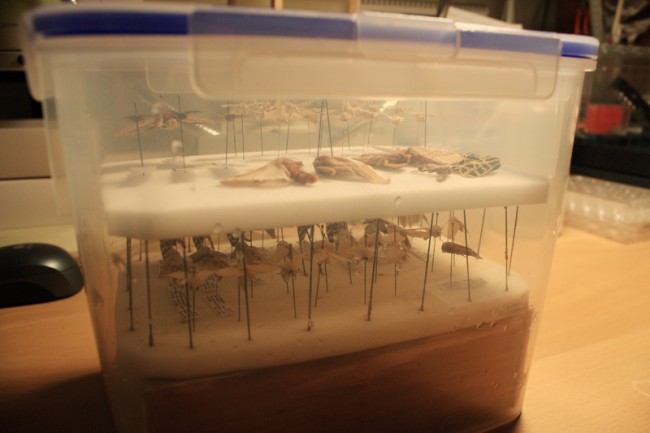 I create a support frame by cutting the bottom off of and then out of a smaller Tupperware container – essentially a rectangular plastic support (the frame in the image is wood, which was my old method). הדבר זה שומר את תחתית מצמיד פני השטח מחוץ למים, מה שאומר שזה קל מאוד להרים את. הצבת הקצף ישירות על גבי מים גורמת להידבקות קלה שגורמת להסרת קשה, במיוחד ללא טפטוף או תזה. במסגרת אני סותם את מגבות נייר לספיגה.
I create a support frame by cutting the bottom off of and then out of a smaller Tupperware container – essentially a rectangular plastic support (the frame in the image is wood, which was my old method). הדבר זה שומר את תחתית מצמיד פני השטח מחוץ למים, מה שאומר שזה קל מאוד להרים את. הצבת הקצף ישירות על גבי מים גורמת להידבקות קלה שגורמת להסרת קשה, במיוחד ללא טפטוף או תזה. במסגרת אני סותם את מגבות נייר לספיגה.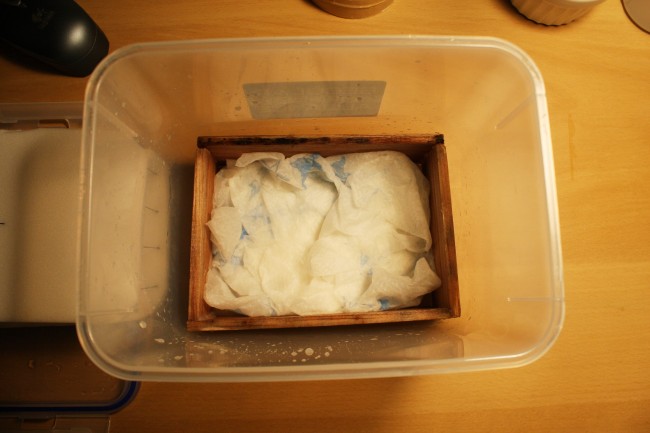 מוסיף מים ברז מספיק כדי ללחלח את המגבות אבל להיזהר שלא לאפשר למים עומדים. זה רק אמצעי זהירות כדי להימנע מהתזות, במיוחד אם המכל נתקל או הפיל. Recently I’ve been using deionized water, which seems to work faster than tap water; and I avoid using hot water because the excess steam creates too much condensation that can drip onto the specimens. התאוריה שלי היא איטי יותר טובה יותר, אין סיבה למהר דגימות טובות! אבל אם אי-פעם בעומס אני אוסיף מים חמים או בעדינות לחמם את relaxer והקפד להשאיר את השכבה העליונה ריק כטפטוף-שומר. בעת השימוש במים חמים כדי להיות בטוח כדי לבודד את חלקו העליון של המכל שלך כדי לעזור להתנגד עיבוי. אבל, חום יכול ליצור שימון עודף במינים מסוימים, אז זה יש להימנע אלא אם כן הכרחי!
מוסיף מים ברז מספיק כדי ללחלח את המגבות אבל להיזהר שלא לאפשר למים עומדים. זה רק אמצעי זהירות כדי להימנע מהתזות, במיוחד אם המכל נתקל או הפיל. Recently I’ve been using deionized water, which seems to work faster than tap water; and I avoid using hot water because the excess steam creates too much condensation that can drip onto the specimens. התאוריה שלי היא איטי יותר טובה יותר, אין סיבה למהר דגימות טובות! אבל אם אי-פעם בעומס אני אוסיף מים חמים או בעדינות לחמם את relaxer והקפד להשאיר את השכבה העליונה ריק כטפטוף-שומר. בעת השימוש במים חמים כדי להיות בטוח כדי לבודד את חלקו העליון של המכל שלך כדי לעזור להתנגד עיבוי. אבל, חום יכול ליצור שימון עודף במינים מסוימים, אז זה יש להימנע אלא אם כן הכרחי!- אני חותך קצף תולה מגשים להתאים. שימוש #7 סיכות (חלד יהיה הכי טוב) אני יוצר היקפי על גבי אשר מספר שכבות של מגשים יכולות להיות ממוקמות בתוך מכולה אחת; שתי סיכות האמצע ממוקמות כמשיכה. השכבה התחתונה לא יכולה להכיל דגימות גדולות עם dorsally כנפיים המקופלות, אבל הם יכולים גם להתאים בשכבה העליונה או כאשר רק אחד שכבה מנוצלת.
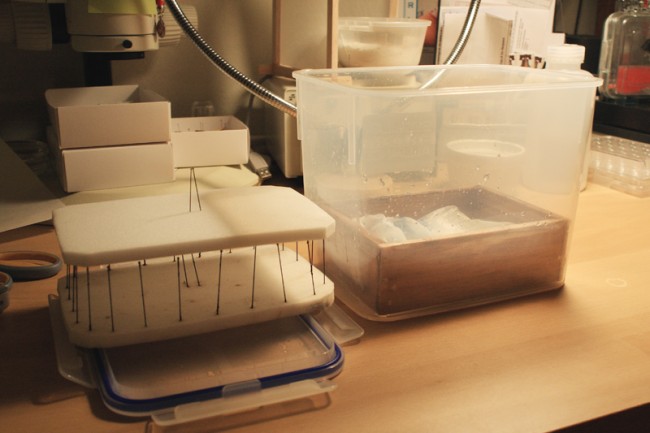
- אז לטעון דגימות ומקום לתוך relaxer. לדגימות מכוסות נייר-עיתון אני פשוט מניח אותם על גבי שטוח הקצף, אבל זה מרחב-חכם לא יעיל. בדרך כלל זה לוקח 6-8 שעות לmicroleps להיות רגועים, 1 יום לleps קטן או עדין כמו Noctuids או Geometridae הדקים ו 2-3 ימים עבור רוב תנשמיתיים ואפילו Saturniidae. נראים רפרפיים בדרך כלל לקחת 4-5 ימים, ועקשנים אלה אני מזריק עם כמות קטנה של מים כדי להקל על מרגיע. אני בדרך כלל יכול להפיץ את התוכן של relaxer אחד ב 4-5 שעות (לפעמים משתרע על פני 2 לילות) ומאז יש לי רק 20 הפצת לוחות מעולם לא הייתה לי הצורך בבניית חדר מרגיע שני.
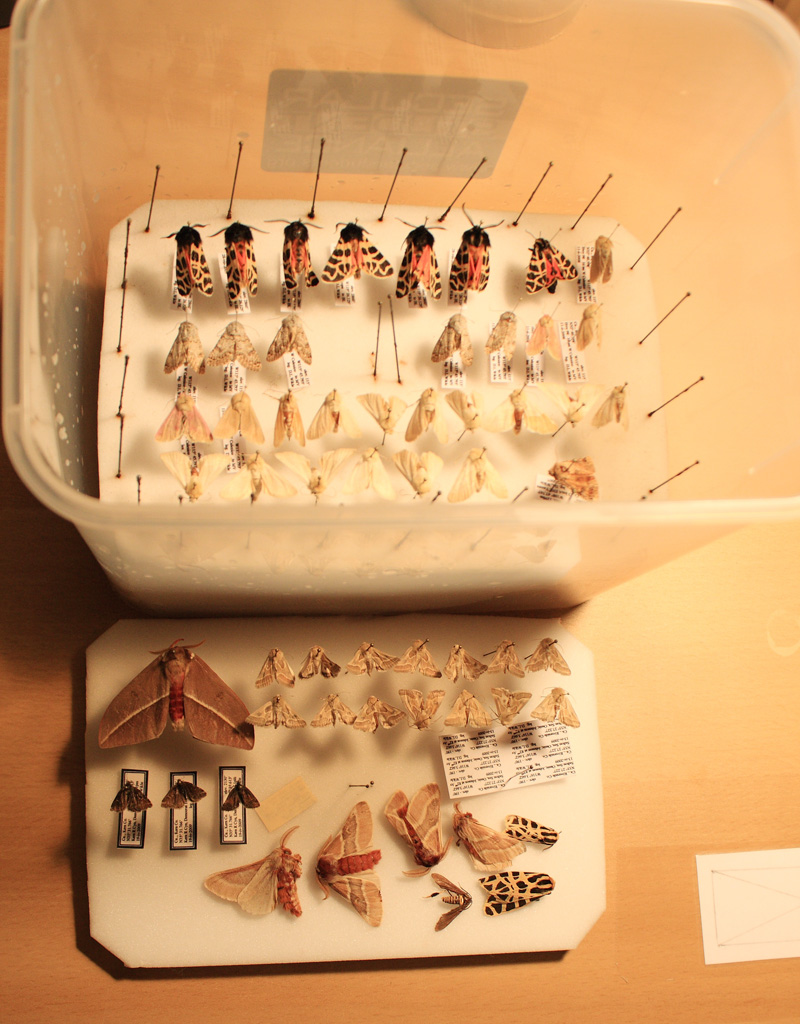
- אני עושה לא להוסיף דוחה עובש כימי כגון chlorocresol, נפטלין או PDB. נהגתי PDB לכמה שנים, אבל האדים קיצוניים, במיוחד כשעובדים ליד השולחן שלך במשך שעות. במקום זאת לשטוף היטב את כל המשטחים עם 95% אתנול לעיקור לאחר כל שימוש (מים רותחים עלולים להיות תחליף). אני תאפשר רק שאריות אתנול דקות בגלל עודף האלכוהול מעכב מרגיע נכון ואתה בסופו של דבר עם כנף מפרקים פריכים, גם לאחר שבוע. למרות ששיטה זו מונעת עובש ל 5-6 ימים זה לא הוכחה טיפש. שכחתי על דגימות ובתוך 7-8 ימים כמה עובש אור יתחיל. למרות זאת, אני מוצא בשיטה זו יוצרת דגימות הכי רגוע באופן משביע רצון מכל דבר שניסיתי.
התוצאות!
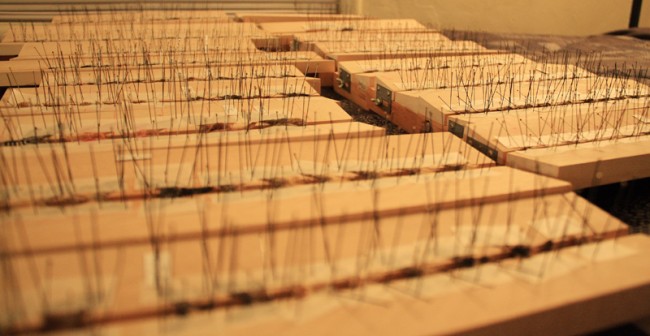

אחי.
Im בהחלט הולך חייב לנסות את זה, השיטה היחידה שאני למדתי לleps הייתה טובלת את החזה במים רותחים. אף פעם לא אהבתי את הרעיון, ותמיד היו תוצאות מעורבות. האם ניסית מרגיע קבוצות חרקים אחרות בדרך זו?
אגב, I like the set up and concept of you website and enjoying learning about what Lep freaks do 🙂
כן זה יעבוד בסדר גמור עבור כל קבוצה של חרקים, לי Hymenoptera רגוע בדרך זו עם תוצאות מצוינות. חלק מחיפושיות גדולות באמת אלה אם לוקחים מאמץ נוסף, ואני לא עזרתי שם!
אני יכול לדמיין את שיטת הטבילה היא גסה, אני מנסה להימנע מכל מגע עם מים.
הנה שיטה מרגיעה חלופית שבו אתה יכול להשתמש עבור מהיר מרגיע: זה עושה את העבודה במהירות, אלא גם מקבל דברים די לחים.
http://www.insectnet.com/videos/instruct/billrelax/billrelax.htm
תודה!
היי,
יש לך פרפרי Mikro רגועים ???
אני meen הקטן אחד.
ואיך אתה יכול לשלוט בפרפר לא להירטב ??
לגבי
ליף
לעש זעיר מאוד אני לא נרגע – דברים כמו Nepticulidae יש לפרוס בעודו בחיים באופן חלקי או מאוד, נהרג מאוד טרי. רוב המינים הזעירים צריכים להיות מותקנים בדרך זו אם בכלל. כשאני מוצא אותם במלכודת אור אני פשוט להצמיד אותם ללא מתפשט. אבל כאשר הם על גיליוני ללכוד בבקבוקונים קטנים להכנה תחת מיקרוסקופ למחרת.
שמירה על המים בטמפרטורת חדר שומרת על העיבוי מינימאלי. מעולם לא היו לי טיפות להרכיב על דגימות.
מה עליי לעשות אם אני רגוע באג כמו 3 פעמים כמו 3 ימים כל אחד וזה עדיין לא גמיש. זה חיפושית אייל והרגליים לזוז, לא הלסתות
חיפושיות הן מקרה מיוחד, ולעתים קרובות דורשות שיטה שונה לחלוטין למנוחה. מהירות הצללה דגימה במים חמים או רותחים יכול לעשות את העבודה – הגוי המרגיע בטמפרטורת חדר הוא באמת רק לדגימות עדינות כמו פרפרים. אולי כדאי לך לחפש מסביב באתרי לוגר חיפושית עצה טובה יותר על מרגיע גדול, נוקשה, חיפושיות. בהצלחה!
“רק” 20 לוחות מתפשטים?! אני כל כך מקנא בך ובכישוריך mothing. בניתי מתפשט לוח עצמי בשל תקצוב וזה קצת… רוצה.
בכל מקרה, השאלה שלי היא זו. אני ללכוד את רוב הדגימות שלי סביב 9 או 10:00, וישירות להעביר אותם לצנצנת להרוג שלי. אני משאיר את צנצנת הלילה ולהפיץ אותם בבוקר בסביבות 8:00. אני כבר ציינו כמה קושי בהפצת האנטנות וכנפיים; האנטנות נוטות להתכרבל והכנפיים תמיד לחצו בחוזקה נגד הגוף, ולכן קשה לחלץ אותם ללא נזק וסוג של קפיץ טעון, רוצה לחזור לגוף ברגע שאני עוזב את המלקחיים. אני לא מפזר / פינר מנוסה, כפי שרק לאחרונה הפסקתי לשחרר דגימות, ואני תוהה אם היה לכם טיפים בשבילי. אני משאיר אותם בצנצנת להרוג יותר מדי זמן? לא מספיק זמן? האם אני צריך להירגע אחרי לילה אחד בלבד לאחר לכידה?
תודה רבה, הבלוג שלך הוא מדהים ומעורר השראה לחוקר חרקים שאפתנים חברים שלא ממש “לקבל את זה”… אני בכיר בתיכון ואני משאבים חסרים לlepidoptergeekery! אנא המשך לכתוב.
אוליביה
תודה על התגובה שלך אוליביה! איזה סוג של הריגת צנצנת אתה משתמש? ייתכן שאתה משאיר אותם זמן רב מדי, אם אני משאיר אותם בלילה אני נוטה להירגע לכמה שעות לפני שמתפשט רק כדי לעזור להפיג את המתח. אם אתה אוסף בבית אתה צריך גם לשקול שימוש במקפיא שלך. אם אתה מפיל את הדברים בצנצנת הרג אתה יכול להעביר אותם לטאפרוור עם נייר אריזה דק ומכניס אותם למקפיא. כאשר אתה מסיר אותו כדי להיות בטוח, כדי לאפשר לו להגיע לטמפרטורת חדר במשך לפחות שעה לפני שאתם מתחילים להתפשט שוב, הכל צריך להיות מושלם טרי.
הייתי פשוט נתפרתי צנצנת להרוג זמנית עם צנצנת שימורים וכדור צמר גפן ספוג במסיר לק. אני אשתמש במקפיא מעתה והלאה, למרות ש, תודה רבה!
אני להרטיב נייר מגבת בצלחת פטרי עם בית חומץ להירגע coleoptera. להשאיר אותם ל24h או יותר במידת צורך. זה עובד מצוין בשבילי. אין בעיות עם עובש או אם אתה משאיר אותם זמן רב יותר.
hello, i am debasish working on red banded mango caterpillar and i want to make the adult spread for preservation, can somebody help me to achieve that goal.
Am new to microlepidoptera………..but having a blast exploring the fauna of my area. The problem!……..pinning. I have collected coleoptera for over 40 years and that’s a pice of cake compared to micro-leps.
The specimens whose wings are basically flat when captured sem to be no problem regardless of size, but the moths which have sort of a triangular, pyramidal shape are the tough ones for me…….I succeed with about 1 ב 10 !!! can’t seem to get the wings moved forward regardless of how carefully I use the pins without tearing or them breaking completely off.
The other problem are the ones where I move the forewing forward and then it flips up creating a long tear in the wing.
Help!!!!
Mike Poellot Saratoga, קליפורניה
Oops sorry for the late reply! Yes when a moth dies with the wings vertical it’s very hard to prepare the specimen. I pin the moth between my fingers as if it’s a large butterfly – then I use two forceps to manipulate the specimen upside down. One pair holding it over the foam and the other pair opening the wings as I pin it down. From there you can then gently pull the wings forward for spreading (if that makes sense?) It takes lots of practice with those!
שלום שם
does anybody like to share some tipps about how you’re relaxing large saturniidae like for example an Argema mittrei or Actias luna?
How to prevent the hairy body to catch too much humidity and still to get the muscles very tender relaxed. And the wings not getting soaked in humidity?
Maybe placing the specimen vertically in the relaxing box or conventional laying on a cotton surface?
Would appreciate a lot if somebody could describe here how you’re handling the process. I had an incident with an Actias luna which turned to be destroyed – water was sticking together the hairs on the body….
Any help and tipps are very appreciated.
Sounds like you’re leaving them in too long or using hot water? With room temp water even a big moth won’t become perfectly relaxed, but you can try injecting some warm water directly into the body to speed things along. Small syringes are cheap and easily purchased online. You can inject a little hot water into the moth and then relax it for 24 שעות, which should suffice.
Okay – גדול, thank you a lot. Used that technique for a papilio antimachus. Worked quite well. Indeed I’m normally using hot water in my relaxing-box.
As you say i should maybe try with room temperature water.
שלום,
I have been mounting butterflies and moths for a few years but am still trying to perfect relaxing. If I use water, the specimens mould in 3 days and before some are relaxed. I read posts of a whole group of guys using vodka as a relaxing fluid. I have been using it for the last month with mixed results. I don’t get mould anymore but many of the saturniids get saturated bodies which mats the hairs. Maybe the problem has to do with the apparent need to inject fluid (vodka) into the bodies. אחרת, heavy bodied specimens won’t relax sufficiently, even after 4 ימים. I bought a can of P-Choro-m-Cresol from Bioquip to add water but I don’t have any idea how much of the crystals to add to how much water. רעיונות כלשהם? It doesn’t seem that any of you are using this method, but I am open to any and all suggestions.
Randy
I think one of the necessary things to do when using only water is to sterilize your container as much as possible – that can help with mold issues. But for large bodied moths and beetles you can inject a little warm water into their thorax before relaxing (you could cut it with alcohol, but I never found it necessary as long as you make sure you dry the specimens after). This will help a lot in cutting down the time required and will really help penetrate the dense muscles. The chlorocresol can work but it’s nasty stuff, leaving a strong odor and potentially has dangerous human side effects. The residue on the specimens can also cause them to relax easily in the future with even a little bit of humidity, causing specimens to droop.
כריס,
Thanks for the advice.
In sterilizing the relaxing containers, would washing in a dishwasher be sufficient or do you recommend something more rigorous? I am using rubbermaid food storage containers.
כמו כן, I am about to try using Lysol. Any ideas about that?
Randy
A dishwasher would be perfect – but I’m not that strict about it. I just wash with 95% ethanol or I use boiling water. That usually takes care of things well enough.
כריס,
I’m finally getting around to standardizing the mounting height of the butterflies in my collection. It will be a fair task now that I have accumulated about 300 of them. I have a pinning block that I bought from Bioquip but I see a problem with it’s use. It standardizes the position of the bottom of the specimens rather than the tops. Since I have everything from tiny blues to the largest Saturnids, this poses a problem. It seems that I should be wanting to standardize the position of the top of the wings, or at least the tops of the thoraxes rather than the bottom of the thoraxes. What spacing should I use between the bead on the tops of the pins to the tops of the thoraxes?
Randy
I standardize the height by pinching the top of the pin and moving the specimen up to that height. It’s enough that my fingers don’t touch the specimen, and I just eyeball it – turns out to be about ~.4″/10מ"מ. Half an inch is a bit much, and you don’t want the specimen being too close to the top such that fingers would contact the specimen. Some pinning blocks (the Rose Entomology design aluminum ones) have a larger hole that fits a pin head, which is exactly 10mm for distancing specimens down from the top.
I’ve a number of problems setting moths.
Particularly noctuids e.g. darts (and I have the same problems with skippers too).
These insects are strong fliers, that hold their wings in a low v shaped tent folded into the body.
Even if these are fresh, moving the forewing into position often causes the joint at the body to fold in on itself (the forewing twists at the joint). I’ve tried relaxing the specimens but to no avail.
It’s difficult to present them to the board at the right height because the wings slip into resting position into the grove – which means lost scales when I try to flatten them onto the setting surface.
What am I doing incorrectly?
It’s getting frustrating.
I read once in a Peterson guide that you could cut the joint below the wing with a fine blade, but this doesn’t seem worth it, and perhaps isn’t necessary – but with these particular moths especially (given the wing position) one can’t even attempt this because you can’t see the wing base.
Am I not relaxing these fresh specimens for long enough?
I feel like I’m missing something obvious.
On another subject, where can I get really good fine point forceps?
Thanks in advance for any suggestions.
הטוב ביותר,
Matt.